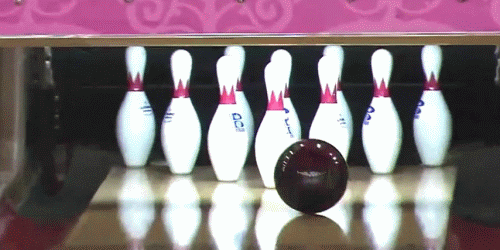Tenpin bowling
 Tenpin bowling is a type of bowling in which a bowler rolls a bowling ball down a wood or synthetic lane toward ten pins positioned evenly in four rows in an equilateral triangle. The goal is to knock down all ten pins on the first roll of the ball (a strike), or failing that, on the second roll (a spare). While most people approach modern tenpin bowling as a simple recreational pastime, those who bowl competitively, especially at the highest levels, consider it a demanding sport requiring precision and skill.
Tenpin bowling is a type of bowling in which a bowler rolls a bowling ball down a wood or synthetic lane toward ten pins positioned evenly in four rows in an equilateral triangle. The goal is to knock down all ten pins on the first roll of the ball (a strike), or failing that, on the second roll (a spare). While most people approach modern tenpin bowling as a simple recreational pastime, those who bowl competitively, especially at the highest levels, consider it a demanding sport requiring precision and skill.An approximately long ''approach'' area used by the bowler to impart speed and apply rotation to the ball ends in a ''foul line''. The , lane is bordered along its length by ''gutters'' (''channels'') that collect errant balls. The lane's long and narrow shape limits straight-line ball paths to angles that are smaller than optimum angles for achieving strikes; accordingly, bowlers impart side rotation to ''hook'' (curve) the ball into the pins to increase the likelihood of striking.
Oil is applied to approximately the first two-thirds of the lane's length to allow a "skid" area for the ball before it encounters friction and hooks. The oil is applied in different lengths and layout patterns, especially in professional and tournament play, to add complexity and regulate challenge in the sport. Especially when coupled with technological developments in ball design since the early 1990s, easier oil patterns common for league bowling enable many league bowlers to achieve scores rivaling those of professional bowlers who must bowl on more difficult patterns—a development that has caused substantial controversy.
Tenpin bowling arose in the early 1800s as an alternative to nine-pin bowling, with truly standardized regulations not being agreed on until nearly the end of that century. After the development of automated mechanical pinsetters, the sport enjoyed a "golden age" in the mid twentieth century. Following substantial declines since the 1980s in both professional tournament television ratings and amateur league participation, bowling centers have increasingly expanded to become diverse entertainment centers.
Tenpin bowling is often simply referred to as ''bowling''. ''Tenpin'', or less commonly ''big-ball'', is prepended in the English-speaking world to distinguish it from other bowling types such as bowls, candlepin, duckpin and five-pin. Provided by Wikipedia
Showing 1 - 20 results of 25 for search 'Schmidt, Gottfried', query time: 0.12s
Refine Results
In addition to media from the THWS, media from other Bavarian libraries are also displayed.
These are marked with the "Interlibrary loan" label and can be ordered by clicking on them.
These are marked with the "Interlibrary loan" label and can be ordered by clicking on them.
-
1
Daniel Suderman 1550 bis frühestens 1631 Versuch einer wissenschaftlich begründeten Monographie. Inauguraldissertation ... der ... Philosophischen Facultaet ... Leipzig. Eingereich... by Schmidt, Gottfried Hermann
Published 1922Call Number: Loading…
Located: Loading… -
2
Über die beiden syrischen Übersetzungen des 1. Maccabäerbuches by Schmidt, Gottfried
Published 1896Call Number: Loading…
Located: Loading… -
3
Über die beiden syrischen Übersetzungen des 1. Maccabäerbuches by Schmidt, Gottfried
Published 1896Call Number: Loading…
Located: Loading… -
4
Einige Worte über den Seelenreiz und eine neue Behandlungsart des Wahnsinns by Schmidt, Gottfried August Heinrich 1776-1805
Published 1803Call Number: Loading…
Located: Loading… -
5
Weiße Stunden und pechige Krucken jagen rund um den Achensee by Schmidt, Gottfried
Published 1998Call Number: Loading…
Located: Loading… -
6
Leitfaden zum Fischartenschutz in Nordrhein-Westfalen by Schmidt, Gottfried
Published 1994Call Number: Loading…Indexes
Located: Loading…
-
7
Discursus hist. phys. de avis Britannicae, vulgo anseris arborei, ortu & generatione by Funck, Georg 1665-1704, Schmidt, Gottfried
Published 1689Call Number: Loading…
Located: Loading… -
8
Die Buchbinderei Vater in Jena by Steinbach, Manfred 1937-2017, Schmidt, Gottfried
Published 2007Call Number: Loading…
Located: Loading… -
9
Artenhilfsprogramm Bitterling (Cyprinidae: Rhodeus sericeus amarus) by Schmidt, Gottfried W.
Published 1982Call Number: Loading…
Located: Loading… -
10
Texte zur Musiktherapie Aufsätze zum Thema Musiktherapie, ihren Praxisfeldern und Anschlußgebieten der verbalen und visuellen Kommunikation sowie einer Bibliographie deutschsprachi... by Mayr, Stella 1924-, Rosenthal, Georg 1937-2019, Freymann, Claus-D. 1938-, Schmidt, Gottfried, Eschen, Johannes T. 1925-2013, Kemmelmeyer, Karl-Jürgen 1943-, Decker-Voigt, Hans-Helmut 1944-
Published 1975Call Number: Loading…
Located: Loading… -
11
Rundwanderungen Lauenburg-Lübeck by Schmidt, Gottfried
Published 1975Call Number: Loading…
Located: Loading… -
12
Retikulärer und kortikaler Schlaf von Früh- und Neugeborenen polysomnographische Untersuchungen by Schmidt, Gottfried Otto
Published 1993Call Number: Loading…
Located: Loading… -
13
Statistischer Beitrag zum Fertilitätsproblem des Mannes by Schmidt, Gottfried
Published 1966Call Number: Loading…
Located: Loading… -
14
Untersuchungen über die Entrindung von Buchen-Faserholz by Schmidt, Gottfried
Published 1965Call Number: Loading…
Located: Loading… -
15
Beiträge zur Konstruktion mechanischer Sprungsysteme by Schmidt, Gottfried
Published 1975Call Number: Loading…
Located: Loading… -
16
Statistischer Beitrag zum Fertilitätsproblem des Mannes Auswertung von 1522 routinemäßigen Fertilitätsuntersuchungen sowie von 570 Nachuntersuchungen aus der Dermatologischen Klini... by Schmidt, Gottfried
Published 1966Call Number: Loading…
Located: Loading… -
17
Die Organisation des Terminwesens auf Eisenhüttenwerken, insbesondere Walzwerken by Schmidt, Gottfried
Published 1935Call Number: Loading…
Located: Loading… -
18
Einige Worte über den Seelenreiz und eine neue Behandlungsart des Wahnsinns by Schmidt, Gottfried
Published 1803Call Number: Loading…
Located: Loading… -
19
Ideen zu einer Physik der organischen Körper und der menschlichen Seele by Schmidt, Gottfried August Heinrich 1776-1805
Published 1803Call Number: Loading…
Located: Loading… -
20
Commitatio de Tito teknō gnēsiō Paulli, Tit. I. 4. by Schmidt, Gottfried Eberhard 1744-
Published 1761Call Number: Loading…
Located: Loading…
